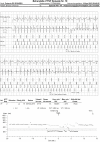Implantable cardioverter defibrillator therapy in grown-up patients with transposition of the great arteries-role of anti-tachycardia pacing
- PMID: 30034851
- PMCID: PMC6035964
- DOI: 10.21037/jtd.2018.01.159
Implantable cardioverter defibrillator therapy in grown-up patients with transposition of the great arteries-role of anti-tachycardia pacing
Abstract
Background: Grown-up patients with surgically corrected dextro-transposition of the great arteries (dTGA) as well as patients with congenitally corrected transposition of the great arteries (ccTGA) carry a high risk of ventricular arrhythmias. Data regarding implantable cardioverter defibrillator (ICD) therapy and efficacy of anti-tachycardia pacing in these patients is limited.
Methods: Clinical data from a contemporary cohort of ICD carriers with atrial switch-corrected dTGA and burdened right ventricle or with ccTGA were obtained retrospectively from hospital records and patients were followed for additional 25 months prospectively. Clinical characteristics and ICD episode data were analyzed.
Results: Fourteen ICD carriers (8 male) with dTGA or ccTGA were included in the analysis. Four patients received the ICD for primary prevention based on severely reduced systemic ventricular function. The remaining patients had an ICD indication for secondary prevention. Cumulative follow-up added up to 113.5 patient-years. One patient died suddenly due to massive pulmonary embolism. One patient received a ventricular assist device. There were no arrhythmic deaths during the prospective follow-up period. Nine patients (64%) experienced a total of 177 ventricular tachyarrhythmias. Anti-tachycardia pacing was highly effective with 80% success rate in termination of arrhythmias. Five patients (36%) suffered from a total of 28 inappropriate ICD shocks for supraventricular tachycardia.
Conclusions: In a contemporary cohort of ICD carriers with dTGA and ccTGA we observed a high proportion of appropriate ICD therapies for ventricular tachyarrhythmias. Over a period of up to 15 years almost two thirds of the patients received appropriate therapies. ATP was highly effective in our cohort and should therefore be programmed whenever possible.
Keywords: Implantable cardioverter-defibrillator (ICD); anti-tachycardia pacing; sudden cardiac arrest; transposition of the great arteries.
Conflict of interest statement
Conflicts of Interest: The authors have no conflicts of interest to declare.
Figures

Similar articles
-
Outcomes following the implantation of cardioverter-defibrillator for primary prevention in transposition of the great arteries after intra-atrial baffle repair: a single-centre experience.Europace. 2016 Jul;18(7):1016-22. doi: 10.1093/europace/euv297. Epub 2015 Dec 23. Europace. 2016. PMID: 26705566
-
Outcomes of defibrillator therapy in catecholaminergic polymorphic ventricular tachycardia.Heart Rhythm. 2014 Jan;11(1):58-66. doi: 10.1016/j.hrthm.2013.10.027. Epub 2013 Oct 11. Heart Rhythm. 2014. PMID: 24120999
-
Primary prevention implantable cardioverter-defibrillators in hypertrophic cardiomyopathy-Are there predictors of appropriate therapy?Heart Rhythm. 2021 Jan;18(1):63-70. doi: 10.1016/j.hrthm.2020.08.009. Epub 2020 Aug 12. Heart Rhythm. 2021. PMID: 32800967
-
Implantable cardiac defibrillator among adults with transposition of the great arteries and atrial switch operation: case series and review of literature.Int J Cardiol. 2014 Nov 15;177(1):301-6. doi: 10.1016/j.ijcard.2014.09.015. Epub 2014 Sep 28. Int J Cardiol. 2014. PMID: 25499397 Review.
-
Interventional electrophysiology and its role in the treatment of cardiac arrhythmia.Ann Acad Med Singap. 1998 Mar;27(2):248-54. Ann Acad Med Singap. 1998. PMID: 9663319 Review.
Cited by
-
The evolution of mechanical circulatory support (MCS): a new wave of developments in MCS and heart failure treatment.J Thorac Dis. 2018 Jun;10(Suppl 15):S1688-S1691. doi: 10.21037/jtd.2018.05.205. J Thorac Dis. 2018. PMID: 30034839 Free PMC article. No abstract available.
-
Ventricular fibrillation in congenitally corrected transposition of great arteries treated with pacing: a case report.Eur Heart J Case Rep. 2019 Oct 30;3(4):1-6. doi: 10.1093/ehjcr/ytz199. eCollection 2019 Dec. Eur Heart J Case Rep. 2019. PMID: 32123788 Free PMC article.
References
LinkOut - more resources
Full Text Sources
Other Literature Sources
